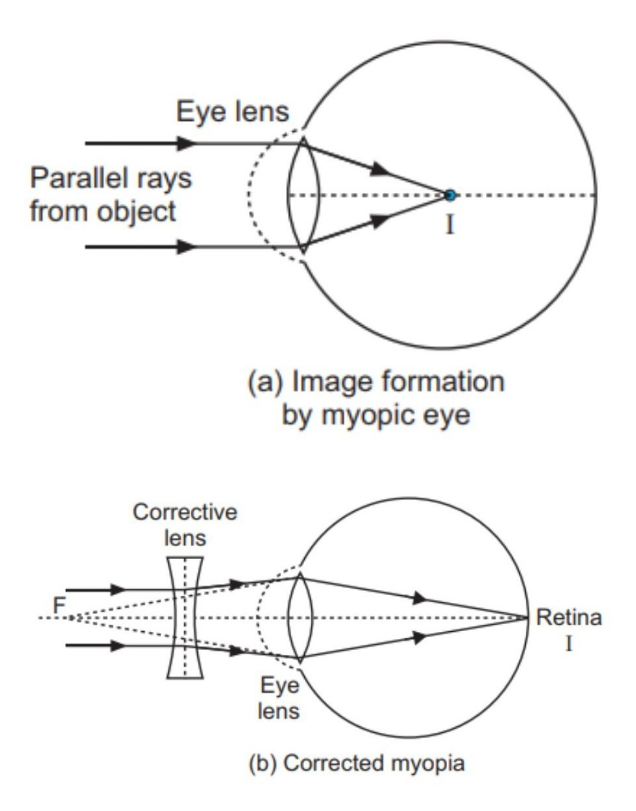
Explain myopia with the help of a ray diagram?
Answer
563.7k+ views
Hint: Myopia is a vision disorder in which we can have a clear look of closer objects but the far objects appear blurry. It is also known as near-sightedness.
Complete step by step answer:
For normal eye functioning, the cornea, and lens bend light so it focuses on the retina. The retina behaves like a screen where the picture is formed by the bending of light rays. It sends the picture to the brain through the optic nerve, which is actually part of the brain.
In a myopic disorder, the eye is longer than normal or has a cornea that is too steep. As a result, light rays focus in front of the retina instead of on it. Therefore, you can see near objects clearly, but distant objects will appear blurred. That’s the reason, this disorder is also called near-sightedness.
To correct the myopic defect of vision, we require a lens that can diverge the incoming rays. Out of both the lenses, the concave lens has the ability to diverge incoming rays. Therefore, it is used to correct this defect of vision. The image is allowed to form at the retina by using a concave lens of suitable power.
The myopic defect of vision as well as its correction is depicted below in the diagram.

Additional Information:
Myopia is a kind of refractive error. By refractive error, we mean that an error in the vision when the eye does not bend the light properly.
Note:
This question requires you to know the exact difference between different types of vision problems.
Myopia can be caused by
1. increase in curvature of the lens.
2. increase in the length of the eyeball
Complete step by step answer:
For normal eye functioning, the cornea, and lens bend light so it focuses on the retina. The retina behaves like a screen where the picture is formed by the bending of light rays. It sends the picture to the brain through the optic nerve, which is actually part of the brain.
In a myopic disorder, the eye is longer than normal or has a cornea that is too steep. As a result, light rays focus in front of the retina instead of on it. Therefore, you can see near objects clearly, but distant objects will appear blurred. That’s the reason, this disorder is also called near-sightedness.
To correct the myopic defect of vision, we require a lens that can diverge the incoming rays. Out of both the lenses, the concave lens has the ability to diverge incoming rays. Therefore, it is used to correct this defect of vision. The image is allowed to form at the retina by using a concave lens of suitable power.
The myopic defect of vision as well as its correction is depicted below in the diagram.

Additional Information:
Myopia is a kind of refractive error. By refractive error, we mean that an error in the vision when the eye does not bend the light properly.
Note:
This question requires you to know the exact difference between different types of vision problems.
Myopia can be caused by
1. increase in curvature of the lens.
2. increase in the length of the eyeball
Recently Updated Pages
A man running at a speed 5 ms is viewed in the side class 12 physics CBSE

The number of solutions in x in 02pi for which sqrt class 12 maths CBSE

State and explain Hardy Weinbergs Principle class 12 biology CBSE

Write any two methods of preparation of phenol Give class 12 chemistry CBSE

Which of the following statements is wrong a Amnion class 12 biology CBSE

Differentiate between action potential and resting class 12 biology CBSE

Trending doubts
What are the major means of transport Explain each class 12 social science CBSE

Which are the Top 10 Largest Countries of the World?

Draw a labelled sketch of the human eye class 12 physics CBSE

Explain sex determination in humans with line diag class 12 biology CBSE

Explain sex determination in humans with the help of class 12 biology CBSE

Differentiate between homogeneous and heterogeneous class 12 chemistry CBSE




